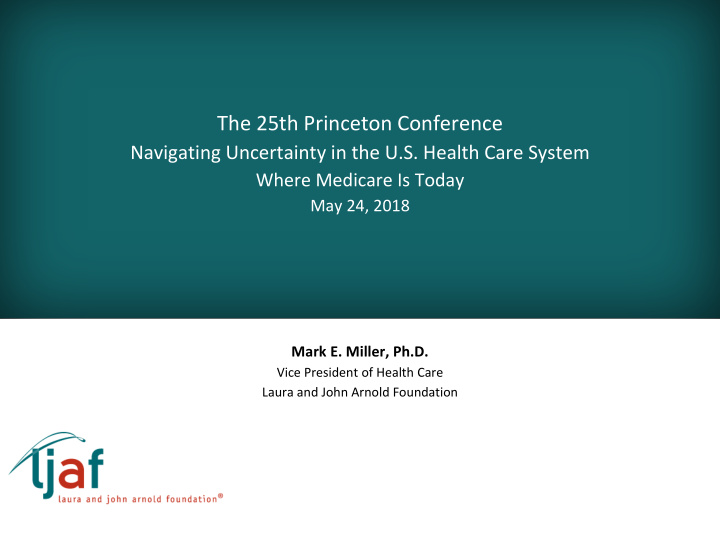



The 25th Princeton Conference Navigating Uncertainty in the U.S. Health Care System Where Medicare Is Today May 24, 2018 Mark E. Miller, Ph.D. Vice President of Health Care Laura and John Arnold Foundation
Topics 1. External Forces Impacting Medicare − Drug prices, provider consolidation, and quality metrics 2. Near-term Issues Across Sectors − Hospitals, physicians and other health professionals, Medicare Advantage (MA), drug prices, Post Acute Care (PAC) 3. For Q&A: Medicare and Large Scale Reforms − Delivery system reform, premium support, benefit design, negotiation in Part D, public options to buy into Medicare 2
Forces Outside Medicare: Drug Prices • Medicare drug spending: o Part B: $29 billion; Average Sales Price (ASP) o Part D: $100 billion; negotiated by PBMs o A + B drugs: ~$40-50 billion; FFS and MA • Profit financed “innovation” + patent and exclusivity gaming + anticompetitive behaviors + mechanisms of the supply chain = high prices • Effect on Medicare: o Higher program spending and higher beneficiary spending (premiums, deductibles, and co- payments) in parts B and D o Hospitals complain of cost pressures under PPS • As the pipeline shifts to specialty and biologics, prices will be higher and PBMs ’ leverage will be less • Policy actions: o Reformulate support for innovation o Patent and exclusivity reforms o Medicare and Medicaid payment reforms o Reforms at the state level 3
Forces Outside Medicare: Provider Consolidation • Consolidation: o Hospital and physician practice – horizontal consolidation o Hospital and physician – vertical consolidation o Evidence – consolidation increases provider prices without change in quality • Effect on Medicare: o Commercial insurers pay well above costs and well above Medicare which creates pressure on Medicare to increase payments o Purchasing of physician practices generates “facility fees” increasing Medicare spending without any increase in quality or access o Free standing EDs: inflates routine/urgent care spending o Stronger lobbying • Policy actions: o Commercial market reform through state and federal actions (e.g. limit out of network charges) o Developing public options (e.g. Medicare buy-in) o Attorney General actions (e.g. Sutter Health in CA) o FTC actions on anticompetitive behaviors 4
Forces Outside Medicare: Quality Metrics • Overbuilding of quality measures with a focus on process measures o Fragmented approach across multiple insurers • Effect on Medicare o Increased administrative costs o Burden on program to administer and providers to report o Creates gaming opportunities, confusion, and the added value is unclear o MIPS delay, exemptions, and ensuing debate is a reflection of the issues in quality measurement • Policy action: o Medicare leads with fewer population based measures to create consensus across industry 5
Near-term Issues: Hospitals • Restrain payment updates • Uncompensated care in the case of slowed or rolled back coverage o Medicare covers more than $10 billion worth of uncompensated care and DSH to hospitals annually • Sustain pressure on site neutral payments • Free standing emergency departments payment reform • Sustain pressure on 340B program reforms (e.g. take discount savings for program and beneficiaries and/or use revenues to support uncompensated care) 6
Near-term Issues: Physicians and Other Health Professionals • Payment rates under MACRA • Delay and exceptions to MIPS need to be addressed o Tension between measurement at the individual physician level vs population level • Balance of the fee schedule between procedural services and cognitive services • Need to pay primary care on “block” basis to allow for flexibility for non face-to-face transactions and coordination with specialists and social services • Administrative burden and payment issues around quality measures, Electronic Health Records (EHR), and new interventions (telehealth) 7
Near-term Issues: Medicare Advantage • Continual improvement in risk adjustment • Coding abuses – Up-coding by ~8% in MA resulting in additional spending of ~$4 billion annually • Quality and measurement in Star Rating System: definitions, weighting, county equity, and gaming • Condition specific benefits and non-medical services • Encounter data o Completeness o What can we learn from it? o Should we use it to change the risk model? 8
Near-term Issues: Drugs • Part B o Inflation caps o ASP is reduced or converted to hybrid o Biosimilars paid in the same code with reference biologic • Part D o Put greater catastrophic risk on plans accompanied by increased flexibility (e.g. eliminate selected protected classes) o Full catastrophic protection for the beneficiary o Gap discount – depth and how it should be counted towards catastrophic coverage o POS rebates o Definition of “rebate” and allocation between program and plan o Integration into ACO models 9
Near-term Issues: Post Acute Care (PAC) • Issue area is defined by: 1. SNF, home health, IRF, LTCH: ~$60 billion (FFS) annually 2. Medicare is the preferred payer - Medicare pays well above costs 3. Lack of definition about what constitutes good practices 4. High degree of geographic variation • Pressure on rates • Bundling PAC with hospitalization • Pressure on utilization from ACOs and MA • Consolidation? 10
Contact Information Mark E. Miller, Ph.D. Vice President of Health Care Laura and John Arnold Foundation mmiller@arnoldfoundation.org (202) 854-2863 11
Recommend
More recommend